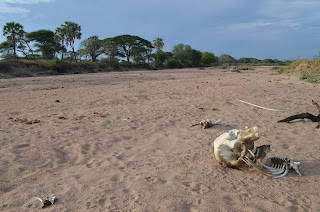 |
| Photo credit to our friend who took these great pics! |
One of the most difficult and sought after mammals to view in Tanzania is the African Wild Dog. Not only is it endangered with very few remaining in the wild but its movements are also unpredictable. There aren't any spots that have a high chance of viewing year round (unlike, for example, the rhino) and seeing them often comes down to luck. We are lucky because Ruaha National Park is one of the places with a relatively high chance of seeing them, especially when they are denning.
There are only around 6,000 African Wild Dogs left in the wild with habitat destruction and disease largely contributing to their decline. They need a huge territory and with habitat loss much of their historical range is now fragmented. There were a few that were equipped with satellite collars and their movements took them throughout Tanzania thousands of kilometers before the collars battery died. As a result, they can be sighted in strange places and usually only for a short duration of time. One was even seen near the peak of Mt. Kilimanjaro!
We had heard there were some African Wild Dogs in Ruaha National Park and decided to take a trip to try to see them. We spend the night and woke up at 5:30 to try to take advantage of the first light as the dogs are most active in the mornings and evenings. We drove to an area of the park where they had been seen and I was a bit discouraged because the area was dense with bush and thus we couldn't scan very far. Right when I was giving up I saw a few dogs moving on the side of the road.
I couldn't believe our luck. The dogs, in true canine behavior, approached us with curiosity and got within 10m of our car! We watched them play for about a half hour before we heard a lion roaring quite close! The dogs took notice and casually moved back towards a hill in denser bush. We were in awe to have such an intimate time with the dogs and watching them relax and play in the morning all alone is one of the top wildlife experiences I've had in Tanzania!
 |
| Each dog has a unique coat pattern |
 |
| Chillin in the grass. |
 |
| I was in shock as Ana tries to get her phone out for a quick picture. |








